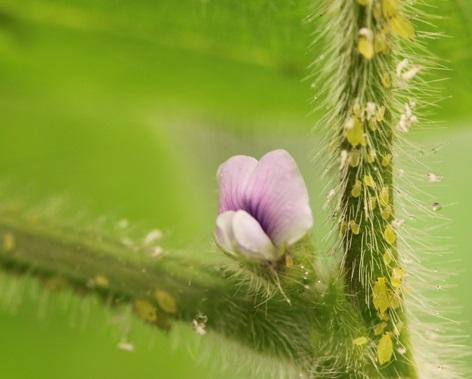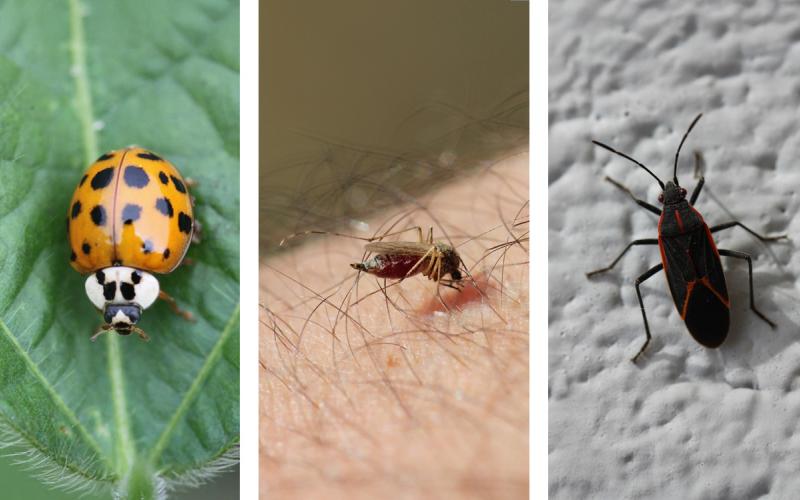Economic Threshold for Soybean Aphids

Written collaboratively by Adam Varenhorst, Mike Dunbar, and Amanda Bachmann.
When gearing up for soybean aphid scouting it is important to think about the population densities that warrant insecticide management. At SDSU Extension we recommend using the threshold of 250 soybean aphids per plant on 80% of the examined plants, or the speed scouting method.
While the 250 soybean aphids per plant is not the exact economic threshold, it is actually more conservative than the economic threshold calculated for soybean aphids in a 2007 research paper (Ragsdale et al. 2007). The economic threshold (ET) for soybean aphids that allowed for a seven day lead time (days from discovery of the population to when it would begin causing economic losses) was 273 soybean aphids per plant. That economic threshold was calculated using data collected from six states during 2003, 2004, and 2005. The action threshold of 250 soybean aphids per plant on 80% of the examined plants continues to be used because it fell within the limits of the newly calculated ET, and it was easier to remember.
It is important to remember that 250 soybean aphids per plant is not the population threshold that triggers economic losses due to soybean aphid feeding. That population is called the economic injury level (EIL), and in the same 2007 research paper it was determined to be 674 soybean aphids per plant. Researchers determined that the damage boundary (the population of soybean aphids that cause detectable yield losses) for soybean aphids is approximately 485 soybean aphids per plant. Therefore, economic injury levels that fall below 485 soybean aphids per plant have no practical value because yield loss can’t be detected at those populations.
Calculating Economic Injury Levels
Using the equations from the 2007 paper, economic injury levels can be calculated using current values for soybean and costs of insecticide applications. Economic injury level and economic thresholds were calculated using insecticide cost (Table 1) and an application fee of $5.25/A.
What we observe is that although updated EILs and ETs for soybean aphids are lower than 674 and 250 they either fall well below the boundary level of 485 soybean aphids, or very close to the original values (Table 2). Remember that aphid populations below 485 per plant do not cause detectable yield loss.
There are several other reasons why very low thresholds are unrealistic for soybean aphids. The most important of these is the presence of natural enemies in the field. Natural enemies are other insects or arthropods that prey on pest insects. Very small populations of soybean aphids may be removed from soybean by several insect species that feed on or parasitize them. Applying insecticides at much lower thresholds would not result in increased revenue, and would remove natural enemy populations and contribute to increasing the chances of insecticide resistance development in soybean aphid.
| Insecticide | Rate | Cost per Acre ($) |
|---|---|---|
| Warrior II (lambda-cyhalothrin) | 0.96 fl oz/acre | 2.74 |
| Warrior II (lambda-cyhalothrin) | 1.6 fl oz/acre | 4.56 |
| Lorsban Advanced (chlorpyrifos) | 1 pint/acre | 5.56 |
| Lorsban Advanced (chlorpyrifos) | 2 pints/acre | 11.11 |
| Endigo (lambda-cyhalothrin + thiamethoxam) | 3.5 fl oz/A | 5.45 |
| Endigo (lambda-cyhalothrin + thiamethoxam) | 4 fl oz/A | 6.22 |
| Insecticide | Cost of Insecticide Application per acre ($) |
Current SD soybean market value ($/bushel) | Average SD Soybean Yield (bushels) | EIL (soybean aphids/ plant) |
ET (soybean aphids/ plant) |
|---|---|---|---|---|---|
| Warrior II (0.96 fl oz/A) |
7.99 | 10.01 | 46 | 280 | 113 |
| Warrior II (1.6 fl oz/A) |
9.81 | 350 | 141 | ||
| Lorsban Advanced (1 pint/A) |
10.81 | 388 | 157 | ||
| Lorsban Advanced (2 pints/A) |
16.36 | 600 | 243 | ||
| Endigo (3.5 fl oz/A) |
10.70 | 384 | 155 | ||
| Endigo (4 fl oz/A) |
11.47 | 413 | 167 | ||
|
*Values marked in bold fall below the boundary level of 485 soybean aphids, or the level at which yield loss from soybean aphid feeding is not detectable. This list is not meant to be comprehensive. |
|||||
The Downsides of Prophylactic Insecticide Applications
Prophylactic insecticide applications are detrimental to production, and can actually result in insect pest resurgences. This occurs because a pest population may be present in a field, but it is constrained by natural enemies that are also present. Applying insecticides when no economic injury is occurring removes the few pests that were present, and also the natural enemy populations. Pests, especially soybean aphids, are capable of rapid recolonization and repopulation of a field, which results in the need for additional insecticide applications, because natural enemies are no longer present.
The prophylactic application of insecticides also increases the selection pressure towards the active ingredients that are being used. Over time the continued use of an insecticide can result in populations of the pest overcoming and being resistant to the product or insecticide class. For soybean aphids, populations that are resistant to the pyrethroid class of insecticides have already been detected in Minnesota (Koch 2016). In addition, prophylactic applications represent unnecessary input costs.
Speed Scouting Method
Speed scouting for soybean aphids is an alternative to using the traditional method of counting all of the aphids on 20 to 30 plants with the 250 soybean aphid threshold. Speed scouting is a binomial sequential sampling program that is actually based off of the 250 threshold. It was designed to provide a method of scouting that would save time, but still provide accurate management decisions.
The speed scouting method uses a decision population of 40 aphids per plant, and is accessible either through a worksheet or a phone app called Aphid Speed Scout.
To use the speed scouting method, you first assess the soybean aphid populations on 11 random plants while walking in a “W” or “Z” pattern in the field. For each plant, if it has less than 40 soybean aphids you put a “-” on the line and if it has more than 40 you put a “+”. After 11 plants are examined you tally up the “+”s. If there are 6 or less you have reached a do no treat decision for the field. If there are 11, you have reached a treat decision. However, it is necessary to reevaluate the field 3-4 days later to confirm that the population is still present before an insecticide application is applied. If 7-10 “+”s were observed additional plants must be scouted. This method reduces the number of aphids that must be counted on a plant, and provides accurate management decisions.
References:
- Koch, R. 2016. Report insecticide failures for soybean aphid. University of Minnesota Extension.
- Ragsdale, D. W., B. P. McCornack, R. C. Venette, B. D. Potter, I. V. MacRae, E. W. Hodgson, M. E. O’Neal, K. D. Johnson, R. J. O’Neil, C. D. DiFonzo, T. E. Hunt, P. Glogoza, and E. M. Cullen. 2007. Economic threshold for soybean aphid (Hemiptera: Aphididae). J. Econ. Entomol. 100: 1258-1267.
- Ragsdale, D. W., D. A. Landis, J. Brodeur, G. E. Heimpel, and N. Desneux. 2011. Ecology and management of the soybean aphid in North America. Annu. Rev. Entomol. 56: 375-399.


